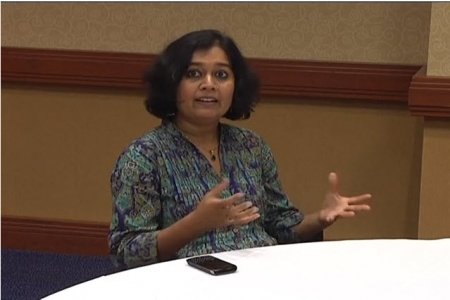“The leadership uses analytics as a way to support their decisions. To me, that’s not necessarily data-driven.”
In a corporation, it is important to build a culture which supports data-driven decision making. There are three main elements to creating this culture
- Hiring visionaries. It’s important to hire fearless visionaries who are willing to change their play on a dime, depending upon the statistics. A great example of this is Zynga, which upgrades every game almost daily and is constantly adding new offerings based upon the statistics.
- Hiring the right skillsets. While it’s tempting to hire an MBA to handle the business and a statistician to handle the statistics, the two may not interact well and plan well. It is often better to hire a data analyst.
- Accountability. Everything must be measured, and direction is key. For example, when skiing, the way to determine direction is to look in the direction you wish to go. Likewise with data-driven behavior, it’s important to keep the goal in focus and continue towards that goal.
Regarding cross-cultural issues in data-driven behavior, Jain says that data is only part of the story. Often data analysis is not done on-location for multi-national companies, so it is important that the data analysts be aware of cultural implications.
Jain refers to her keynote speech in which she describes how to draw $120K incremental revenue from 2 hours of analysis. In brief, there are five steps.
- Determine the business question. Only by examining this question can a business create goals.
- Lay out goals and plans.
- Access the data.
- Analyze the data. Here the technique is crucial. All data must be correctly analyzed. It is important to follow through, and not take shortcuts.
- Tie your incites to the impact.
Making $120K incremental for a million dollar business is no different from how you make $120 million in a billion dollar business. There is a difference in alignment, but the approach is the same.
The McKinsey Report projects that there will be a need for 1.5 million more data analysts by 2018.
Jain says that the future of analytics is to become part of most of the professional positions – it will be part of sales, product, and marketing.
Currently, most people use analytics in daily life anyway. For example, in a new city, most people go to Yelp and choose the restaurant with the highest rating, meaning that most people are already becoming aware of analytics, and soon analytics will become an integral part of many professional fields.
Piyanka Jain, CEO, Aryng
 Piyanka is the founder of Aryng, a well-regarded industry thought leader in analytics, speaking regularly at conferences and consistently being recognized as the “Best Speaker” at business conferences such as Predictive Analytics World, Integrated Business Planning and Business Performance Conference. With her 10+ years in analytics, she has 100M+ demonstrated impact on business. Her prior roles include the head of NA Business Analytics at PayPal and senior marketing analytics position with Adobe.
Piyanka is the founder of Aryng, a well-regarded industry thought leader in analytics, speaking regularly at conferences and consistently being recognized as the “Best Speaker” at business conferences such as Predictive Analytics World, Integrated Business Planning and Business Performance Conference. With her 10+ years in analytics, she has 100M+ demonstrated impact on business. Her prior roles include the head of NA Business Analytics at PayPal and senior marketing analytics position with Adobe.
Daniel Waisberg
 Daniel Waisberg is the Owner of Conversion Journey, a consultancy that provides insights on improving the performance of websites. He is also the founder & Editor of Online Behavior. He is a frequent speaker at industry conferences and member of the Advisory Council of the eMetrics Marketing Optimization Summit. You can follow him on Google+ or on Twitter @danielwaisberg.
Daniel Waisberg is the Owner of Conversion Journey, a consultancy that provides insights on improving the performance of websites. He is also the founder & Editor of Online Behavior. He is a frequent speaker at industry conferences and member of the Advisory Council of the eMetrics Marketing Optimization Summit. You can follow him on Google+ or on Twitter @danielwaisberg.

